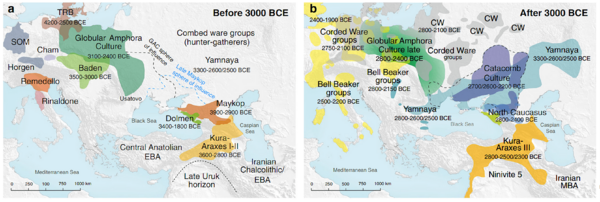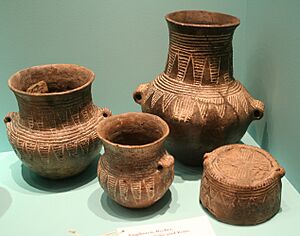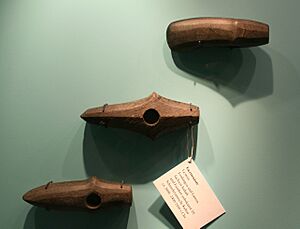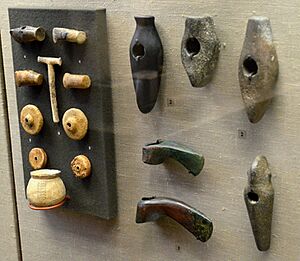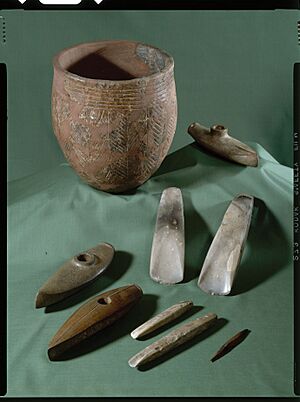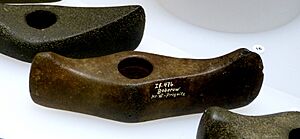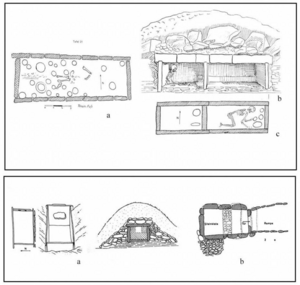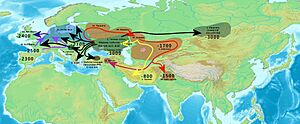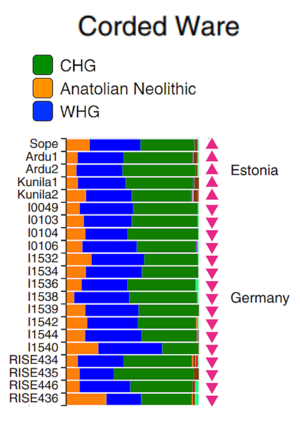Corded Ware culture facts for kids
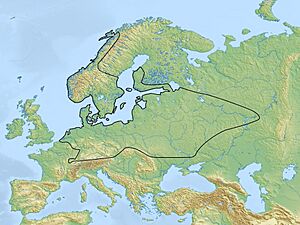 |
|
| Geographical range | Europe |
|---|---|
| Period | Chalcolithic |
| Dates | c. 3000 BC – c. 2350 BC |
| Major sites | Bronocice |
| Preceded by | Yamnaya culture, Cucuteni-Trypillia culture, Globular Amphora culture, Funnelbeaker culture, Baden culture, Horgen culture, Volosovo culture, Narva culture, Pit–Comb Ware culture, Pitted Ware culture |
| Followed by | Bell Beaker culture, Fatyanovo–Balanovo culture, Abashevo culture, Sintashta culture, Mierzanowice culture, Unetice culture, Nordic Bronze Age, Komarov culture |
The Corded Ware culture was a large group of ancient people who lived across Europe between about 3000 BC and 2350 BC. This time period covers the end of the Stone Age, the Copper Age, and the beginning of the Bronze Age. These people lived in a huge area, stretching from the Rhine River in the west to the Volga River in the east. This included parts of Northern, Central, and Eastern Europe. Scientists believe that the Corded Ware culture might have started when people from the Yamnaya culture, who lived in the steppes (large grasslands) of Eastern Europe, moved west. They mixed with the local groups already living there.
Many experts think the Corded Ware culture played a big role in spreading the Indo-European languages across Europe and Asia. These are the languages that most people in Europe and parts of Asia speak today.
Contents
What Does "Corded Ware" Mean?
The name Corded Ware culture comes from the special way these people decorated their pottery. They used twisted cords to press patterns into wet clay. This made unique designs that looked like ropes or cords. A German archaeologist named Friedrich Klopfleisch first used this name in 1883.
Other names for groups within this culture include the Single Grave culture. This name comes from their burial custom of burying people alone under small mounds. The Battle Axe culture or Boat Axe culture is another name. It refers to the stone axes shaped like boats often found in men's graves.
Where Did They Live?
The Corded Ware culture covered most of northern Europe. This huge area included modern-day Germany, the Netherlands, Denmark, Poland, the Baltic states (Lithuania, Latvia, Estonia), Belarus, the Czech Republic, Austria, Hungary, Slovakia, Switzerland, parts of Romania and Ukraine, and even parts of European Russia. They also lived along the coasts of Norway and in southern Sweden and Finland.
Archaeologists have noticed that the Corded Ware culture wasn't just one single group. People in different parts of this huge area had different ways of living and getting food. However, they all shared some key things. These included their special burial customs, pottery with cord decorations, and unique stone axes.
The Bell Beaker culture lived in the western part of Europe at the same time. They shared some ideas with the Corded Ware people. But the Bell Beaker people were better at trading by sea and rivers, which helped them develop new things.
How Did the Culture Begin?
How the Corded Ware culture started is a big question for archaeologists. For a long time, many thought it was the original home of the Proto-Indo-European languages. This was because they used horses and wheeled vehicles, seemed warlike, and spread quickly.
Today, the most popular idea is the "steppe hypothesis." This suggests that the Indo-European languages spread from the steppes of Eastern Europe. Genetic studies show that Corded Ware people share a lot of their ancestry with the Yamnaya culture from the steppes. This suggests a "massive migration" of people from the steppes into Europe.
Some theories suggest that Yamnaya men moved north and married women from local farming communities. However, other experts point out that the male genetic markers (Y-chromosomes) of Corded Ware people are different from those found in Yamnaya men. This means they might not be directly related through the male line. Instead, the Corded Ware culture might have developed alongside the Yamnaya culture, with some influence but not a direct family link.
The Middle Dnieper culture in Ukraine seems to be a link between the Yamnaya and Corded Ware cultures. From there, the Corded Ware culture spread both west and east. The eastward spread led to the Fatyanova culture, which influenced the Sintashta culture. The Sintashta culture is important because it's linked to the early Indo-Iranian languages.
Did it Develop on its Own?
Some researchers believe the Corded Ware culture developed independently in central Europe. They point out that it shares similarities with the earlier Funnelbeaker culture in northern-central Europe.
Early dates for Corded Ware pottery come from Poland, around 3000 BC. However, more recent studies suggest that the Corded Ware culture appeared around the same time across North Central Europe, around 2900 BC. It spread from several "centers" that then formed their own local networks.
Different Groups of Corded Ware People
Middle Dnieper Culture
The Middle Dnieper culture is an early form of the Corded Ware culture. It's important because it was located along an easy route from the steppes into Central and Northern Europe.
Fatyanovo–Balanovo Culture
This culture developed in the upper Volga region from the Middle Dnieper and Eastern Baltic Corded Ware groups. It later influenced the Sintashta culture, which is linked to the early Indo-Iranian people.
Central European Corded Ware
This is the main Corded Ware culture found in Central Europe, especially Germany and Poland. It's known for its pottery with twisted cord patterns. Both men and women were buried with this special pottery.
Single Grave Culture
The Single Grave culture refers to groups in southern Scandinavia, northern Germany, and the Low Countries. They buried their dead alone, often with a battle-axe, amber beads, and pottery. This was different from earlier cultures that used large collective graves.
The idea of the Single Grave culture came from Danish archaeologist Andreas Peter Madsen. He noticed these graves were very different from older burial sites.
The Battle Axe culture in Denmark, Sweden, and Norway appeared around 2800 BC. About 3,000 graves have been found. The "battle-axes" were mostly symbols of importance, not just weapons. There's not much evidence of a large, violent migration. Instead, it seems local farmers in Scandinavia adopted new ideas as cultures changed on the continent.
About 3000 battle axes have been found across Scandinavia. Less than 100 settlements are known, as they were often on farmland that has been plowed over.
The Battle Axe culture in Sweden and Norway continued the farming practices of the earlier Funnelbeaker culture. But the arrival of metal changed their social system. Earlier cultures had large collective graves with many offerings. The Battle Axe culture, however, had individual graves with personal offerings.
How They Lived (Economy)
Archaeologists have found very few settlements of the Corded Ware culture. This led to the idea that they were mostly nomadic herders, like the Yamnaya culture.
However, some evidence shows they also did some farming. Traces of wheat and barley have been found at a Corded Ware site in Poland. They also used wheeled vehicles, probably pulled by oxen, continuing a practice from earlier cultures.
In the northern Alps, people systematically used cow's milk from 3400 BC onwards. In western Switzerland, sheep were kept more often, possibly for their wool.
Burial Customs
Corded Ware people buried their dead in flat graves or under small mounds. On the European continent, men were usually placed on their right side, and women on their left, both facing south. However, in Sweden and parts of northern Poland, graves faced north-south. Men lay on their left side and women on their right, both facing east.
Often, there was a wooden structure in the grave. Graves were sometimes placed in a line. In Denmark, people were buried in layers: the oldest person at the bottom, then another burial on top, and sometimes a third.
Common items found in graves included stone battle axes for men. Pottery, like beakers and other vessels, was also very common. These pots were often decorated with cord patterns. Sometimes, wagons and sacrificed animals were also buried with the dead.
The Bell Beaker culture, which lived around the same time, had similar burial traditions.
Language and Identity
Spread of Indo-European Languages
The Corded Ware culture likely played a central role in spreading the Indo-European languages across Europe. These languages include the ancestors of modern Celtic, Germanic, Baltic, and Slavic languages.
Some theories suggest that early Germanic languages developed in southeastern Central Europe and spread with the Corded Ware culture. Other theories propose that Slavic and Baltic languages developed further east.
Genetic studies support the idea of a large migration from the Yamnaya culture into Europe. This migration could have brought the Indo-European languages with them.
How Languages Changed
When Indo-European speakers arrived in Europe, they met people who spoke different, non-Indo-European languages. Over time, the Indo-European languages became dominant. This often happened through a process called "language shift," where people gradually stopped speaking their old language and started speaking the new one.
Some researchers believe that the Corded Ware culture's arrival in Scandinavia led to the development of the Proto-Germanic language. They suggest that while Indo-European speakers became dominant, some words from the original languages of Scandinavia remained in Proto-Germanic.
Genetic Studies
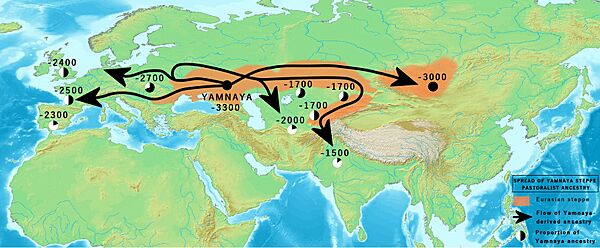
Studies of ancient DNA show that the Corded Ware people had a lot of ancestry similar to the Yamnaya culture. This suggests a big migration from the steppes around 4,500 years ago. For example, DNA from Corded Ware skeletons in Germany was about 75% similar to Yamnaya DNA.
However, scientists also note that the Yamnaya people sampled might not be the direct ancestors of the Corded Ware people. It's possible an earlier group from the steppes migrated to Central Europe.
Modern Europeans still have a significant amount of this "steppe ancestry" in their DNA. This ancestry also brought a genetic component called "Ancient North Eurasian" into Western Europe, which was not present before the Corded Ware culture.
Some studies suggest that early Corded Ware society was "polyethnic," meaning it had different groups of people. This might have happened when Yamnaya-related migrants mixed with local groups like the Globular Amphora culture. For example, some early Corded Ware graves show that local women were included in the culture.
Male Genetic Markers (Y-DNA)
Most Corded Ware men carried a specific Y-chromosome marker called R1a-M417. Some also carried R1b or I2a. It's interesting that while Yamnaya men mostly carried a different type of R1b, the R1b found in Corded Ware men was different. This suggests that Corded Ware men were not directly descended from Yamnaya men through their father's line.
Over time, the R1a-M417 marker became very common among Corded Ware men. This might be because men with this marker had more children who survived, or because more people with this marker moved into the area.
Links to Later Cultures
Genetic studies show that the Corded Ware culture is genetically similar to later cultures like the Bell Beaker culture, the Unetice culture, and the Nordic Bronze Age. People from the Nordic Bronze Age and Corded Ware cultures also show a high ability to digest milk (lactose tolerance).
There's also a close genetic link between the Corded Ware culture and the Sintashta culture. This suggests that the Sintashta culture developed from an eastward movement of Corded Ware people. The Sintashta culture then influenced the Andronovo culture. These cultures are important because they are linked to the early Indo-Iranian people.
Images for kids
See also
- Battle Axe culture
- Funnelbeaker culture
- Fatyanovo–Balanovo culture
- Middle Dnieper culture
- Bell Beaker culture
- Ertebølle culture


